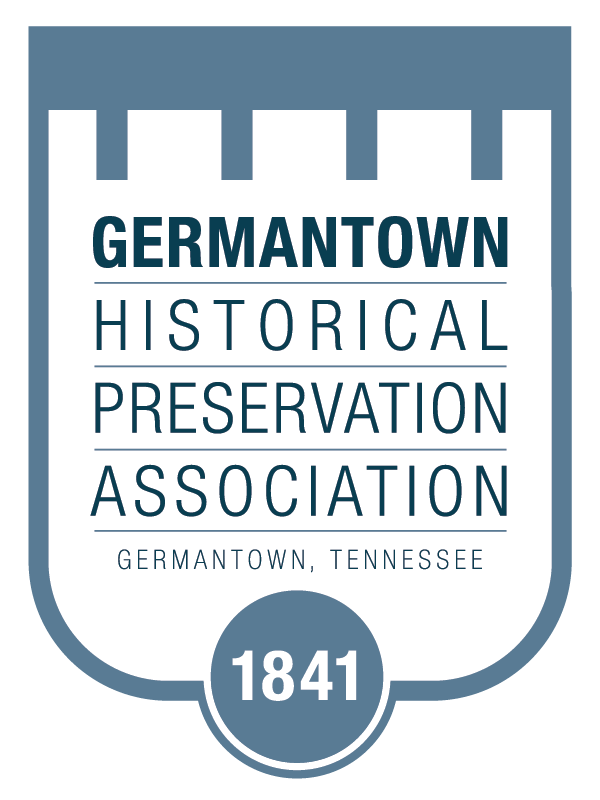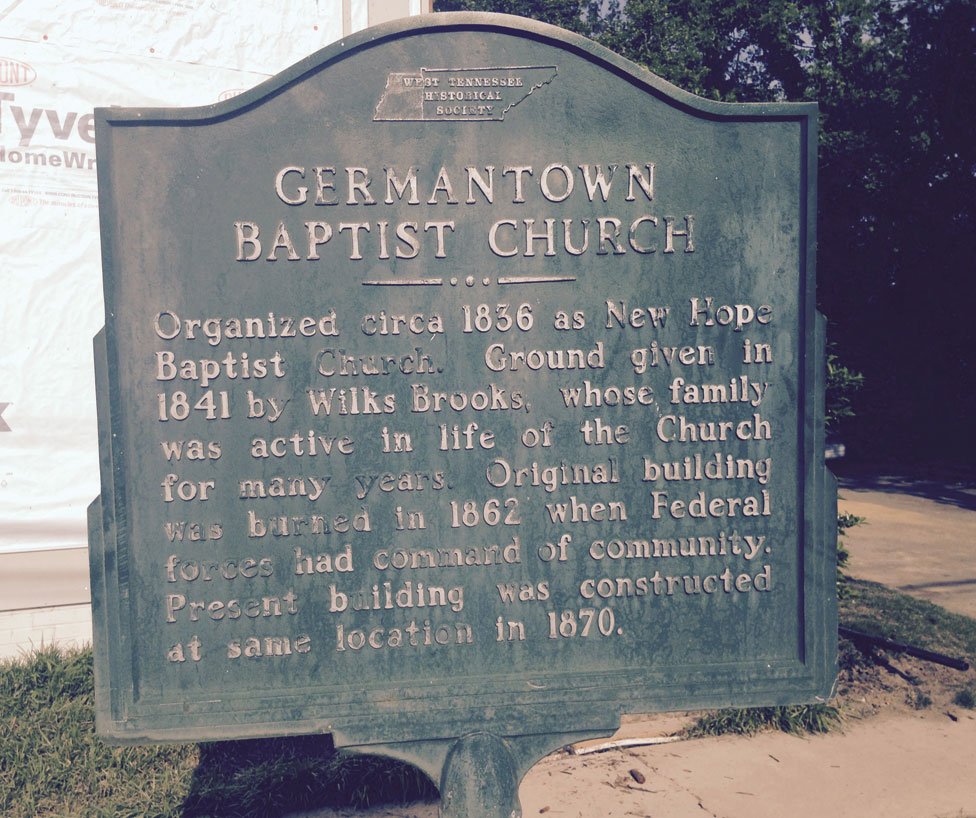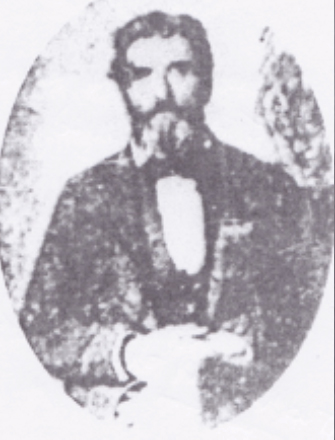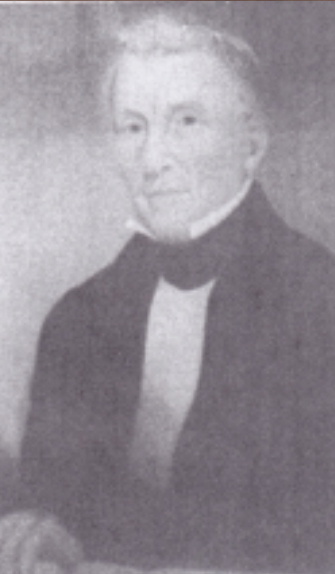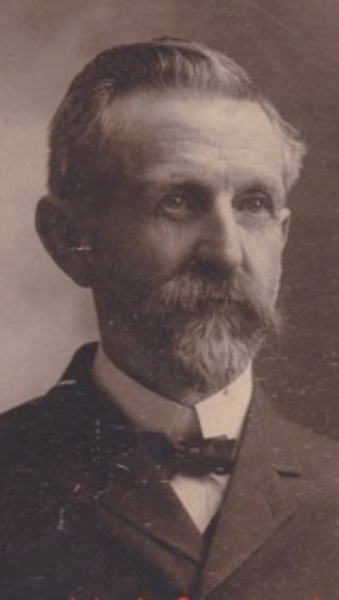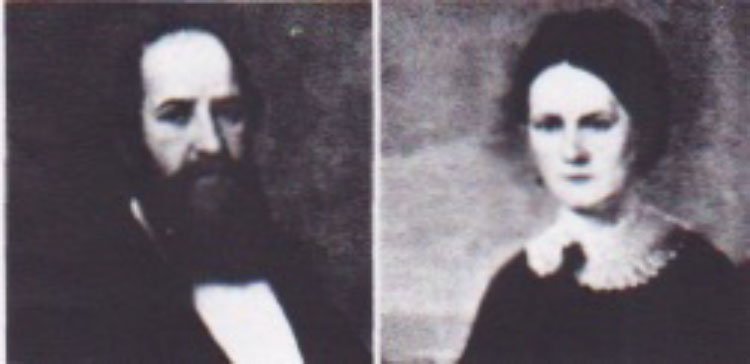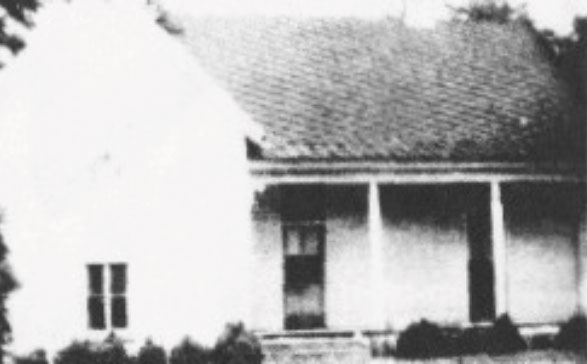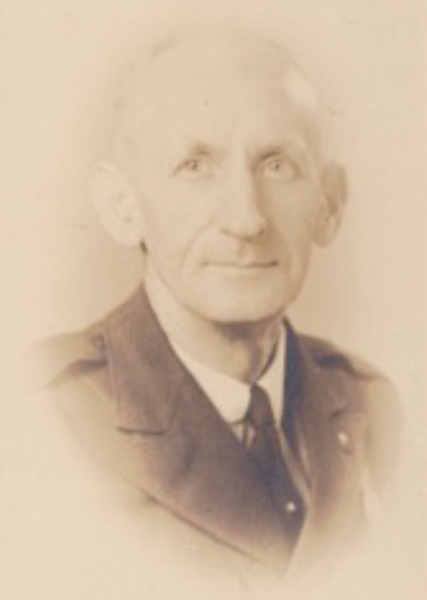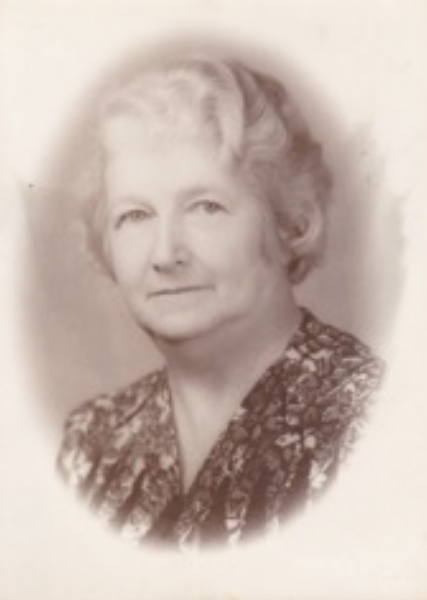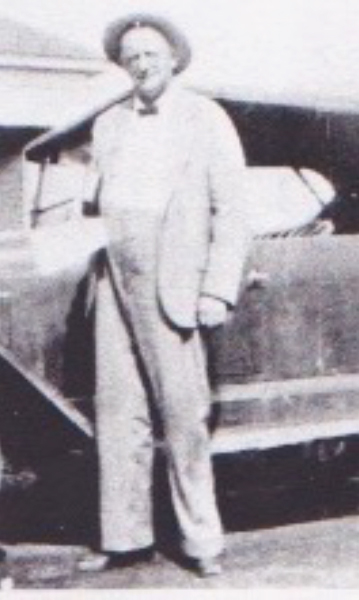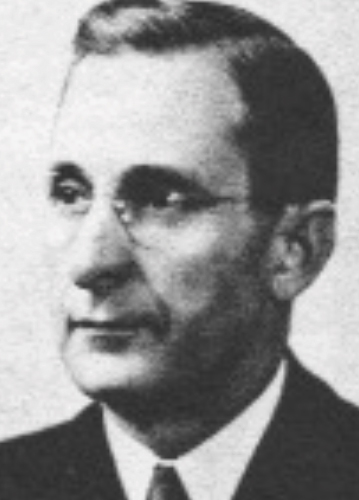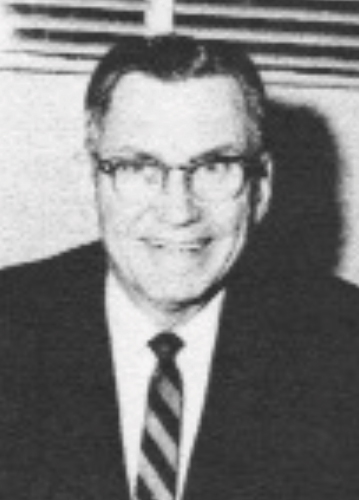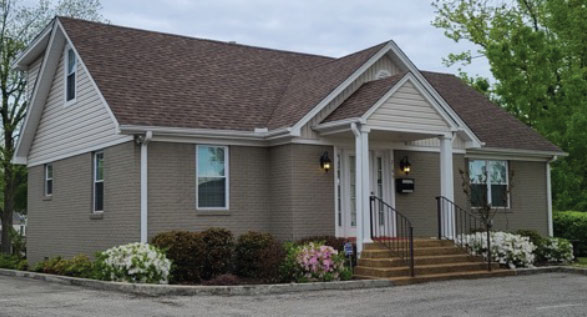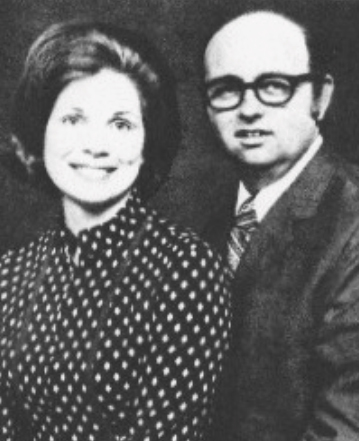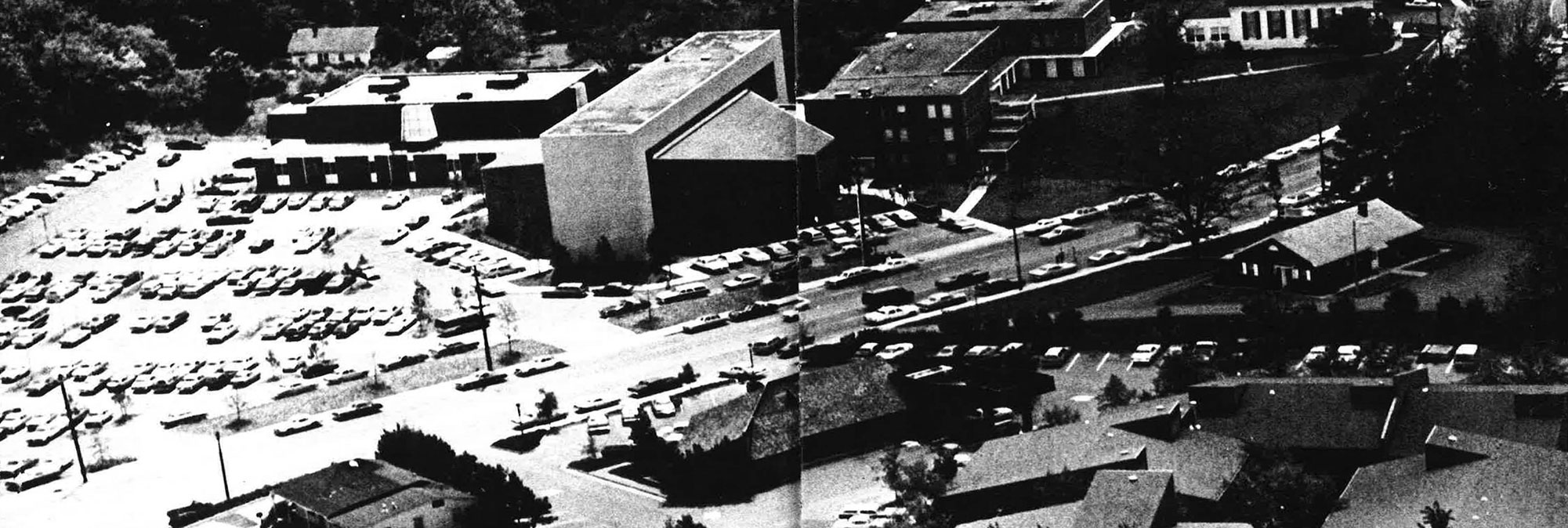
Germantown Baptist Church
By Mrs. Clarence (Eugenia H.) A. Smith
(This history was written for the Germantown Baptist Church Centennial Celebration June 7, 1970)
Chapter II| Chapter III| Chapter IV | Chapter V | Chapter VI | Chapter VII
The early settlers of all faiths worshiped in peoples’ homes prior to their meetings in a log schoolhouse that was built in 1833. The Methodists, Baptists, and Presbyterians used it for a number of years, each occupying the pulpit on alternate Sundays. The Methodists were the first to construct a separate building, followed by the Baptists, and then the Presbyterians.
The early records of the Baptist church were destroyed in several fires or were lost. Because of this, it is not known just when the church was organized. Fortunately, the minute books of the Big Hatchie Association (organized 1828) have been preserved since 1830, and those of the Tennessee publication, The Baptist (now Baptist and Reflector), since 1835. It was in these publications (found in Nashville) that reference to the Baptist Church of Germantown was found. In a letter written August 9, 1838, by Levi Roberts, and printed on page 269 of the Baptist: “Two weeks ago, I received into the church at German Town (New Hope), Shelby County, 49 members of whom I baptized 45.”
The church was a fully organized church by that time, so it was probably started a couple of years prior to that date. Efforts to find a record of the early charter have proven fruitless.
The church was listed in the minutes as New Hope Church through the year 1841. It was on that date that the village of Germantown received its Charter of Incorporation, and thereafter the church was known as the Baptist Church of Germantown.
At the meeting of the Big Hatchie Association, October 1838, New Hope Church with 69 members was accepted into membership. The delegates were Martin Hodges, H. Irvin, and J.A. Harris. Martin Hodges, a licensed preacher, was probably the organizing minister of Germantown Baptist Church in the early 1830s. The delegates in 1839 were Martin Hodges, William Vasser, and Thomas Rutherford. The Vasser Family was active until 1877, and Thomas Rutherford until 1856 when he moved to Arkansas.
And – so it was “a church was born”, but as yet there was no building. It was on December 11, 1841, that Wilks Brooks gave the plot of land on which to construct a building. The Deed describes the plot as being on Bridge Street (now Germantown Road), and part of the Nicey B. Shepherd 65-acre land grant of 1837, which is the same location as now. The deacons named on the Deed to represent the church were Thomas Rutherford, Middleton Black, and James Brooks; witnesses, (Pastor) L.H. Bethell and W.D. Bethell.
There are no pictures of the church, but records found at the United States Court of Claims, Washington, D.C., described it as a white weatherboard with the foundation of brick pillars, one room with columns in the center, a vestibule, carpeted rostrum a steeple, and a bell.
The building was constructed during the ministry of Lemuel H. Bethell (1841-1846). He was ordained in 1835 and was a rather large man of commanding appearance, pleasant and witty. It was said of him that few men were better known or more revered. His education was from the “common schools” but he was known for his “eloquent diction.” He and his wife, the former Elizabeth Buchanan, reared a family of ten. He was probably the first minister called to serve the church.
During his tenure, the first Bible class and a temperance society were formed. Attendance at Sunday services was also evidence of the growth of the church, the membership increased from 71 to 98, and the black membership from 14 to 34. Services were held on the first Sunday of each month from 1843 through 1853; during 1854-1856, on the second and fourth Sundays, and reverted to monthly in 1857.
Little is known of the progress of the church for a few years, but biographies disclose the names of a few ministers who served at Germantown. Any examination of the lives of these men will help to know something of the Baptist beginnings in this area. The minutes of the Big Hatchie Association, the Memphis Baptist Association, and the Shelby Baptist Association provide the names of the pastors, officers, and delegates for each year from 1830 to the present.
One of the well-known ministers was J.L. Cross, who was married to Miss Sarah Barton and first served as pastor in 1850. Due to failing health, they moved to Fayette County, where his wife passed away. After Mr. Cross’s health improved he returned as pastor from 1858 to 1860. He was later married to Miss Kimmons of Iuka, Mississippi. She encouraged him to make every effort to improve himself that he might be better qualified to preach the Gospel. After leaving Germantown he pastored churches at Center Hill, Byhalia, and Olive Branch, Mississippi.
Another pastor in the early years of Germantown Baptist was John Bateman. He was born in Rockingham, North Carolina, and moved with his parents to Carroll County, Tennessee in 1825. Feeling the call to the ministry, and knowing the need for education, he entered the classical school in Denmark, Tennessee, and later at Georgetown, Kentucky. He began preaching in Denmark, then Somerville, Bethany, and Germantown. He resigned in 1852 to fill the pastorate at Helena, Arkansas.
The three churches in the village of Germantown worked very closely together. During associational meetings in one church, the other churches offered the use of their facility, if needed.
The Presbyterians who organized in 1838, had no building until 1851. They met for a number of years at the Baptist Church, and when their building was completed, they sent to the Baptist Church this resolution thanking them for the use of the building.
“1st. We cordially tender to our Baptist Brethren a lively sense of gratitude for the privilege of worshipping God in their sanctuary for so many years. 2nd. God in His kind Providence has enabled us to erect a house to be dedicated to His service, but we now sincerely say to or Baptist Brethren, should their circumstances ever require it, we hold ourselves under obligation to grant them similar favor, if within our power. 3rd. That a copy of these Resolutions be forwarded to the Baptist Church, Germantown.”
– R.R. Evans, Pastor
William Gowen, from Lincoln County, Tennessee, went to LaGrange County, Tennessee after his marriage, and served church principally in Fayette and Shelby Counties. The churches he served in Shelby County were Germantown (1853), Eudora, and Egypt, which is the oldest Baptist Church in the County. In his later years, he taught theology to the black people.
Jeremiah Burns of South Carolina lived for a time in Alabama. His first marriage was to Miss Laviniah Jackson in South Carolina. She passed away leaving several children, then he married Miss Frances Loyd. After he served in Fayette County, he became pastor at Germantown in 1854 where he remained until 1857. In 1859 he was moderator of the Big Hatchie Association when it met at Collierville.
He was an able preacher, having been mostly self-educated. His son said his father learned English with the study of the Bible, which he did at night by the light of a cedar brush. He was medium size, very neat in his dress, and had a winning personality, which made him popular wherever he went.
He presented a large pulpit Bible to the church on September 11, 1858. It was printed in 1856 and published by J.B. Lippincott & Company of Philadelphia, Pennsylvania. Initially, it was in the custody of a great-granddaughter, Mrs. Philip Sullivan, formerly Miss Carrie Callis, and now is in the custody of the Germantown Baptist Church.
Recently, information has been received that in 1848 Joseph Albert C. Clark married Delilah Ann Kinard at the church, but the officiating minister is unknown. However, a relative of this family, Louis Lycurgus Thompson took as his bride Miss Mary Catherine Webb at the church on May 28, 1856, with Jeremiah burns to perform the ceremony. Miss Webb was the daughter of Dr. Randolph Webb and his wife, the former Lucy Dunn. Dr. and Mrs. Webb came to Germantown prior to 1839 and opened a boys’ school in what is now known as the Nurnberger home on Old Poplar Pike at Germanwood Lane. Mrs. Webb transferred her letter from Wake Crossroads Baptist Church, Wake County, North Carolina, in 1839. Dr. Webb remained a Presbyterian, but their children were active in the life of the Baptist Church for a number of years.
Both Mr. Burns and Mrs. Cross continued their work through 1860 when the membership totaled 67 whites and 38 blacks. Mrs. Burns died at age 83.
Chapter III – THE CIVIL WAR YEARS
The Battle of Memphis took place on June 6, 1862, on the Mississippi River. But as early as March the citizens became quite upset over the news of probable trouble in the area.
Federal troops occupied Memphis until the War was over. Troops were also encamped in the Germantown vicinity, about one-half mile to the east and the north, near the Wolf River, from 1862 through 1865. They dispatched their troops to LaGrange and Collierville from this camp. In 1862, they dismantled the Baptist Church and used the wood for a multitude of purposes, making the structure unoccupiable for the purposes of church services. The Presbyterian Church escaped because the Pastor, R.R. Evans, requested they refrain from destroying it. However, they used the area below as a stable and the Masonic Lodge as a hospital.
Mrs. Sally Walker, a charter member of the Presbyterian Church, lived opposite the Baptist Church, and when she saw soldiers destroying the church, sent word by a servant that the pulpit Bible be saved and sent to her. Her request was granted, and this is the Bible that Jeremiah Burns had given to the church during his pastorate.
The War made many changes in the lives of the people, many had died, and others had moved away to escape the War, leaving a population of only 197. The Presbyterians, remembering they had used the Baptist Church for many years, issued an invitation to both the Methodists and Baptists to use their building. This offer was gladly accepted.
Following the War, C.N. Ray became pastor in 1867, followed by J.W. Stein and then J.B. Canada. Mr. Canada, a Virginian, came to Shelby County where he took charge of Prosperity School in Bartlett and was pastor at Germantown from 1870 to 1872. He was a man of deeds as well as of words, having raised the money to build three Baptist Churches. It was during his ministry that the church was rebuilt. A verse found in Nehemiah 4:6 might have had a special meaning for the members at this time – “So build we the wall; for the people had a mind to work.”
The contractor selected to rebuild the church was Edward M. Cole, whose proposal was that cost of labor would be $800 which included construction of the pews, cost of material not included. Carpenters were paid $1.50 to $2.50 per day. The plan was almost a duplicate of the original church. In fact, it is almost as it appears today, clapboard, with tall clear-glass windows, sloped roof, with very tall doors leading into a vestibule where two doors lead into the sanctuary – one to the right, the other to the left. There are only two aisles, and fewer pews then than now, since there were two stoves, one on each side near the front which was used to heat the building. There were hanging lamps, but of different design from those now used, and they were not electric (electricity was not available in Memphis until l882). Over the pulpit were the words, “In God We Trust” which were later removed. In those days the men sat on one side of the sanctuary and women on the other. Perhaps that is the origination of the term “Amen Corner.”
People traveled in carriages, buggies, and wagons in that period, so a place had to be provided for them to wait until the service was over. If the minister came from some distance he would come into the village on a Saturday, spend the night with a hospitable family, stay for Sunday dinner and return home on Sunday afternoon.
With the new building complete, the church began to renew its spirit and reach out to the new prospects, and expect great things for the Lord. This renewal brought a very enthusiastic young pastor to Germantown, W.W. Keep, a native of Dover, Vermont. He was one of the better educated and interesting ministers to serve. His education was from the public schools, and he was engaged in many vocations during his life but began in his father’s blacksmith shop.
At age sixteen, young Mr. Keep had acquired a knowledge of vocal music and several instruments through night study. At this early age, he was elected leader of the church choir at East Brattleboro, Vermont, which was then known as the best choir outside Boston. He had an insatiable interest in education, for by private study and occasional attendance at the Academy he greatly advanced his education and made progress in Latin and the classics, which was of use in later years in the ministry.
Mr. Keep became a Presbyterian and remained there as a member and chorister until he moved to Troy, New York. There he began his first practical knowledge of Baptist doctrine and principles. His study caused him to see the New Testament teachings in a different light and he decided to become a Baptist. He was baptized in the Hudson River by Isaac Orchard. Later he married a daughter of Mr. Orchard, and while his business as a mechanic prospered, Mr. Keep gave much of his “time off” to churches as a teacher, chorister, and conductor; was a member of New York Sacred Music Society and helped to organize the New York Musical Academy. He was also a paid conductor of Broome Street Musical Association. Then moving to Chicago, he became the first conductor of the Musical Academy, where he remained until he moved to St. Louis to become the superintendent of the oldest Sabbath School west of the Mississippi.
Mr. Keep served as a chaplain in the Civil War but soon resigned because of this health. Later he began writing articles for publication in The Baptist and insisted on moving to Memphis to become office editor in 1870.
Mr. Keep visited Germantown Church and soon became its pastor. He assisted in the procedure to obtain a partial payment from the United States Government for the destruction of the church during the Civil War. When the building was complete, he gave the bell in the tower, which, even today, often rings to inform the village that it is the worship hour. In 1873 he moved to Little Rock, Arkansas and later to Texas.
W.J.F. Allen, another Tennessean, educated at Union University at Murfreesboro, became the pastor at Germantown in 1873-74 and again in 1898 – 1900. He had served in the Civil War, then resumed his work as a pastor and a schoolteacher.
William D. Mayfield of South Carolina was a chaplain during the War, then served in Arkansas before coming to Memphis where he took charge of the Southern Baptist Publication Society. He served as pastor at Germantown in 1875, and during his leadership, the membership increased for the first time in recent years – from 47 to 60.
A South Carolinian, John K. Murphy, was licensed to preach in 1859. He served in the War where he lost a limb on Missionary Ridge, but not discouraged, he soon recuperated and was ordained and accepted a pastorate. He completed his studies at Baptist Theological Seminary at Greenville and became pastor of churches in several states before coming to Germantown in 1876. At the same time, he was pastor at Collierville, White Station, and Covington.
John Washington Lipsey began his pastorate on April 1, 1877, and also took charge of the Germantown school. He and his wife were the parents of six children. It was during his tenure (through 1879) that the yellow fever epidemic struck the village, and many lives were lost. When it subsided, Mr. Lipsey held a four-week revival during which forty people came forward, bringing the total membership to 96.
J.D. Anderson filled the pulpit from 1883 to 1886. During this time the churches met together for community prayer meetings, which were very well attended. The Big Hatchie minutes gave special attention to Germantown Church for the two weekly prayer meetings reported. Also, this was the first time a Sunday school was reported for the church (1883). J.M. Scott was its first superintendent, and he was succeeded by G. W. Owen. The first clerk reported was P.N. Overton in 1886.
There were several pastors about whom no information could be found, and perhaps there were pastors whose names did not appear in the minutes of the Association. Without the church minutes, there is no way of determining if some names have been omitted.
A few of the listed pastors were W.C. Bryant, followed in 1889 by J.E. Buchanan, then J.H. Amaker, J.W. Porter, N.W.B. Bacon, W.A. Lusk, and T. J. Davenport. Then W.F. Allen returned for a time. Men who served in other capacities in the early period of the church were John L. Coopwood, R.K. Stephens, F.H. Strickland, and W.W. Gorman.
The village population had increased since the War, with a total of 268 in 1890; the Baptist membership was 83, or about one-third the population. There were several business establishments in the area, among them were five general stores, a hotel, a shoemaker, three physicians, three cotton gins, a sawmill, three saloons, a blacksmith, a builder, and three justices of the peace. Indeed, it was quite a self-sustaining village!
In January 1891, during the pastorage of J.W. Porter, the church received a letter from Mrs. Agnes Brooks (Mrs. Joseph Brooks) whose family was active in the church until 1937-8, proposing to build and donate a parsonage to be used strictly for that purpose, as long as there remains a body worshiping there of the same faith and order.
The parsonage was constructed just to the north of the present church, and it was quite an attractive house in that day. No doubt the Porter family were the first occupants.
About this time three young men were granted licensees, to preach by the church. They were Thomas Penn, N. Kehon and J. Schammerhorn.
The Memphis Baptist Association was formed in 1891, and all but two churches in the area affiliated with it. It was said this Association was a stepping stone to progress and a transitional period of far-reaching magnitude. As a result, the Big Hatchie Association was dissolved in 1903.
During Mr. Davenport’s pastorage (1897), the Memphis Baptist Association minutes contained the following report:
“The three churches contributing the largest amounts in order as mentioned, and the only ones contributing over $100, are First, Memphis, E.A. Taylor, pastor; Germantown, T.J. Davenport, pastor; Millington (pastor not listed). These may be called the banner churches of the Association.”
Chapter V – THE TWENTIETH CNETURY
Germantown Church experienced times of progress and digression, but the people had a deep faith, and the church began to progress.
George Albert Grammer, of Vicksburg, Mississippi, came to fill the pulpit at the beginning of the century. He preached his first sermon to a group of black people when he was only fifteen. He graduated from Mississippi College and married Miss Mary E. Fraser of Memphis. He served in the Civil War where he lost his right arm at the Battle of Shiloh in 1864.
His daughter, Miss Leone Grammer, active in Baptist work, supplied the church with information concerning a diary which her father had kept during the War, from June 9, 1861, through April 1864. While he lay wounded, he lost track of it. Years later he advertised in the Confederate Veteran making an inquiry about it and received a reply stating it had been in possession f Captain J.H. Irwin, of Starkville, Mississippi, for twenty-four years. Mrs. Grammer had it typed and one hundred years later his daughter contacted the Vicksburg Post where it was published in serial form beginning June 19, 1961.
Mr. Grammer’s last pastorage was at Germanton, for he became ill one morning while at the church and died a week later – June 27, 1902.
Born in Fayetteville, Tennessee, in 1879, Edward Wilkinson Reese accepted his first pastorage at Germantown in 1902. While there he served also at Union Avenue Baptist Church, Memphis. He married Miss Bessie Lee Irwin, a schoolteacher, and also an organist at First Methodist Church. She became a Baptist and was baptized by Mr. Reese at Union Avenue where she later served as organist. Finally, Mrs. Reese resigned from his pastorate at Germantown in order to devote more time to the newly organized Union Avenue Church (1902).
E.T. Thorn took up the pastorate but remained only a year, then he was followed by F.W. Muse. During his four-year tenure, the Shelby County Baptist Association met at the church, and he delivered the afternoon sermon. The ladies met at the Presbyterian Church.
Mr. Muse baptized four young girls at the same time in the Wolf River while at Germantown. They have kept in close touch all these years, and two of them became life members of the church – Miss Bess Coopwood who married Jack Barry, and Miss Carrie Callis (Mrs. Phillip Sullivan). The third was Miss Pearl O’Neill (Mrs. John Scruggs) – better known as “Miss Pearl”), who united with the Episcopal Church where her husband was a member, and later returned to the Germantown Baptist Church after his death. The young girl was Miss Bess Payne, now a member of Union Avenue Church. Descendants of the former two young ladies are now active in the Lord’s work at the church where they have been members all their lives.
J.C. Greenoe filled the pulpit in 1910, and a year later Dr. William H. Bruton came. He was a Moderator of Shelby County Baptist Association for three years, and he was also a pastor at Collierville, where he died.
The church pursued its effort to secure some kind of payment from the United States Government for the destruction of the church during the War. The first papers were filed with the United States Court of Claims on March 3, 1887, by E.W. Gorman, Thomas Payne, and J.L. Coopwood. The amount sought was $2500, which was about the estimated cost of a new building. Later depositions were taken from Germantown residents concerning the destruction. These people were Philip Cornelius, Quinton Roberts, Medicus J. Turner, J.C. Rogers, and J.M. Wright, all farmers; Ed M. Cole, a millwright, and builder; E.W. Gorman, member of the church, a bookkeeper and Postmaster at LaGrange, Tennessee, and Mrs. Sally A. Thompson, whose parents had been members of the church.
Finally, the Omnibus Act of 1925 provided that $1250 be paid to the church, which was only half the amount sought. According to the United States General Accounting Office records in the National Archives (which furnished copies of the claim papers), only $1000 was paid. It is presumed the $250 was paid directly to attorneys for legal fees. No doubt any settlement was welcomed after such a long time.
J.R. Burke, came as a minister in 1916, and the next year, S.B. Meyers, followed by J.W. Cunningham (1919), then W.S. Roney. These were the years of World War 1 with Germany when the village became Neshoba. After the war, J.W. Joyner became pastor and the membership increased to 112. It was also the period when the Woman’s Missionary Union was organized.
Other pastors were H.E. VanCamp, W.F. Dorris, J.P. Horton, and L.E. Robertson. Mr. Roberson possessed a beautiful baritone voice and was often asked to praise the Lord in song. During his tenure, Germantown became a full-time church with a membership of 141 and a Sunday School enrollment of 116. The Girls’ Auxiliary was organized under the leadership of Mrs. J.W. Callis, who was Presbyterian, but took some part in the work of the church since her husband was active as a church clerk.
At last, the church was growing, and Sunday School contributed significantly to the growth. It became necessary to provide separate rooms for the classes that had been meeting in the corner of the Rev. sanctuary. An addition was made to the rear of the sanctuary which consisted of a foyer and five Sunday School rooms, one of which later was converted to a. kitchen. Mr. Roberson worked very hard on this addition, doing much of the footwork and labor himself. It was not complete when Dr. W.P. Everson became pastor in 1932. He was a native of Wisconsin, but spent most of his life in the South, having served churches in Kentucky, Tennessee, and Florida. He married a Tennessee girl, Miss Myrtle Loew of Mountain City. While here he returned to his studies at Memphis State University, now the University of Memphis.
Baptist Young Peoples Unions were organized in 1891 and were very successful in affording thousands of young people the opportunity to complete studies of Bible and Baptist doctrine. However, it was 1934 before one was organized at the Germantown Church.
B.W. Hudgson took over the pastorate just as the church was about a century old. It had seen good times and bad, but it was ever mindful that faith conquers all, and its growth is evident. Mr. Hudson stayed for two years, then was succeeded by Dr. James E. Basden, a native of Memphis. He received his A.B. degree from Union University. He married Miss Evelyn Jeter of Brownsville, Tennessee, and later they moved to Texas where he resumed his studies.
Since the church had no baptistry during all these years, baptismal services in the early years were conducted during the warm weather in the Wolf River, in much the same manner as Jesus was baptized in the River Jordan. Later, nearby churches offered the use of their baptistries. Consideration was given to the installation of a baptistry, and approval was given in 1941.
Audie L. Mays was at Germantown from 1943 until 1947. It was at this time that Eugene Moffatt and R.L. Archer were ordained as ministers, then in 1950, Robert Deline was ordained. Through the lives of such young men, the church ministry was far-reaching.
Following Mr. Mays was Paul N. Harlan, then the pulpit became vacant until V.E. Boston became interim pastor. Later he accepted the call and remained for three years. It was during the ministry of J.G. Cooper that the first organ was purchased and installed (1952), and Miss Bess Barry became organist.
By this time the parsonage had reached the state of “old age”, so consideration was given to the purchase of a lot across the street at 219 Germantown Road. The lot was purchased in 1953, and the old parsonage was used for Sunday School rooms until it was removed in the early 1960s.
A committee composed of Dr. J.T. Carter (chairman), Mrs. New Hunt, Roy Winn, F.E. Owen, and Mr. W.E. Chandler were appointed to work on plans for the new pastorium (parsonage). Upon its completion, its first occupant was the family of Lawrence A. Tucker, who had assumed leadership of the church in 1953. He was a Memphian, having attended the city schools, as well as Memphis State University, and later Louisiana College and Northern Baptist Seminary. He married Miss Nancy A. Wilson of Illinois, and he served churches in Illinois, other nearby states, and New York.
In the 1950s a Business’ Women Circle was organized under the leadership of Mrs. Ney Hunt. Miss Caroline Sullivan had served as president of the Business Women’s Circle, the Shelby County Federation of Baptist Business Women, and the Tennessee Federation of Baptist Business Women. Another member, Miss Helen Newton, had served as a pianist of the Shelby County Business’ Women, and the Tennessee Federation of Baptist Business’ Women, as well as a church organist.
It was during this period that definite plans were made to erect the first story of an educational building, and the committee was named for long-range planning. They were Mrs. Paul Haynes, Mrs. Genetta Roast, L.D. West, Mr. and Mrs. Bradley Phillips, Jim Barber, Leon Jones, Bilbo Jones, Gaston Jones, Jon Melton, and Mrs. Durward Simmons.
In 1956 the first Financial Secretary was elected – O.D. Roast and the rotation system for electing deacons was adopted.
Under the ministry of John B. Love in 1959, the initial fund for the new educational building was begun, and the Royal Ambassador Group was formed. Mr. Love reported “many souls were saved” in this period and he “praised God there were no cobwebs in the baptistry.”
Plans for the educational building were well underway when W.F. Wells came as pastor in 1960. He was from West Point, Mississippi, and was married to the former Miss Joyce A. Martin. He went right to work, looking forward to the completion of the building since the need was great. The total membership had risen to 319, and the Sunday School enrollment was 169 – the highest ever. Upon its completion, it was dedicated on February 3, 1963.
Looking forward to a much larger congregation and the need for more parking space, the church purchased a one-acre tract to the north and east of the church in 1962. The following year another tract adjoining the original plot to the north was secured for parking.
With so many young people attending the services, the church noted their interest. It was decided they be given complete charge of one Sunday evening service each month on a trial basis. This arrangement was quite successful, resulting in greater attendance and more concentrated interest. This meant trained leaders who would take responsibility in the future.
The resignation of Mr. Wells on July 1, 1964, prompted the church to appoint a temporary pulpit committee to fill the vacancy as soon as possible.
Chapter VII – THE LONGEST MINISTRY
Kenneth P. Story was called to serve as pastor and began his ministry on December 6, 1964. He was born in Kentucky, graduated from Union University at Jackson, Tennessee where he received a B.A. degree, and graduated from New Orleans Baptist Theological Seminary with a B.D. degree. In 1975 he was given sabbatical leave, returned to New Orleans Seminary where he was awarded a Doctor of Ministry degree. He was married to the former Miss Elizabeth Maxwell, and they had three sons, Stephen, Mark, and Timothy.
Before coming to Germantown, Mr. Story held student pastorates at New Hope Church, Paris, Tennessee, and later at the French Quarter Baptist Chapel, a mission of First Baptist Church in New Orleans. Following his graduation from Seminary, he served the Pleasant Grove Church for two years. He also served as assistant pastor at Oaklawn Baptist Church, Paducah, Kentucky.
Upon coming to Germantown, Mr. Story expressed a desire to build a church and he felt this one had potential. In surveying the conditions of the church, he found that fewer than 100 people were participating in the services, and there was some doubt the church would be able to meet its $16,627 budget.
However, the members had great faith and determination concerning the church. It was not long until this contagious spirit began to revitalize the church, and the pastor set to work by appointing a committee to write a proposed Constitution and bylaws. The committee was composed of Miss Bess Barry, Frank Camp, Arnold Pete Flake, Mrs. Paul Haynes, Johnnie Melton, and Frank Slover. In early 1965 their proposals were presented and adopted.
In 1966 an overall long-range plan for the church was developed and presented whereby the buildings would be arranged in a T-shaped with a sanctuary, seating 500, as the main stem. On either side would be educational buildings.
The first step in the new plan was to add a building for educational use to the annex which was built three years earlier. Plans were approved and construction was begun. This addition included a nurser, dining room, and fellowship hall, also the erection of the exterior walls on the second floor of the entire building. It was completed at a cost of $90,000 and was occupied in 1967.
The sanctuary choir, under the leadership of Miss Caroline Sullivan, was made up entirely of women. However, their presentations were outstanding for such a small group. Soon a few brave men joined the women and others followed.
In 1969 the second floor of the educational buildings was completed at a cost of $22,000, providing eighteen more class and assembly rooms.
With so many young people, the Youth Committee voted to plan church activities that would allow them to become actively involved in Christian service and church life. Soon they began to serve as ushers and to lead in public prayer. Periodic “youth fellowships” were planned with emphasis on personal involvement in the Lord’s work. This led to the formation of the Germantown Baptist Youth Mission Group whose members were available to other churches for speaking, singing, and Christian witnessing engagements. Their objective was to help other churches reach the young people of their communities in Christian work. They went as a group to churches where they spent the day leading the worship services.
Requests came from churches, associational meetings, and youth conferences. The “mission trips” led to the purchase of a bus for transportation. Their success also resulted in other churches forming similar groups.
During the Spring Revival in 1969 forty-four, new members were added to the church, but this was not a new record since in the beginning of this history it was noted that forty-nine had been add to the membership during a revival meeting.
With the approach of the 100th birthday of the sanctuary, plans were made early for a meaningful celebration. A committee was appointed to formulate such plans, and one member was requested to do research for an early history of the church (prior to 1850). There being no local source where this information might be found, she went to Nashville to the Historical Commission of the Southern Baptist Convention. After several days and hours and hours of reading microfilm, she was quite surprised when upon turning a page, THERE IT WAS, as heretofore mentioned.
Succeeding in its search for early history, the committee proceeded to issue invitations to former pastors and members, dignitaries, and friends. The rear foyer was turned into a history room where the walls were lined with newspaper clippings and pictures of early Germantown church historical data. Pictures of former pastors, old pictures – one of a wedding, a Sunday School class, census records, deeds, and the old pulpit Bible were all displayed. Hostesses were available to aid the guests.
The program for the CENTENNIAL DAY celebration (June 7, 1970) consisted of a short history resume, beautiful music by outstanding Memphis artists, and a few words by the Pastor, Mr. Story. At the conclusion of the program, the guests toured the building, viewed the historical display, then proceeded to the dining room where tea was served. Wives of the deacons assisted by their teenage daughters had charge of the tea.
It was indeed a glorious day for the church! It was a reminder that one should use the accomplishments of the past as steppingstones upon which to rise to greater victors in the future.
The little congregation of 69 in 1838 had increased to over 500 in 1970. Even the two-morning services found the seating space often inadequate. With the population “rushing” eastward, the church needed to immediately provide more space.
In February it was voted to construct an interim sanctuary with a seating capacity of 535 at a cost of $155,000. The committee selected for this project was Charles DeWees, James Kelley, Al Laehder, Mrs. Lynn Orr, Miss Mildred Jones, George Valentine, Coy Peeper, Roy Winn, and G.C. Jones. The building was to be placed at the south end of the educational building, and by July the foundation was underway. All went well with the construction, and it was ready for occupancy as planned in November.
The last regular service held in the 101-year-old sanctuary was on Sunday evening, November 14, 1971. The old building is thought of by some as antique, but to others, it has a much deeper meeting. There are many who were baptized and married in the sanctuary; deacons and ministers who were ordained there; others have attended there since infancy, and still others came only to worship. Many people remained long after that final worship service was over to reminisce a bit longer. As the pastor said, “The old sanctuary has been the scene of many victories!”
The new interim sanctuary, with its padded pews, matching draperies and carpeting, and a new Allen organ, was occupied and dedicated on November 21, 1971. The time of the morning services was changed – The Sunday School to meet at 9:15 and the worship service at 10:30 a.m. This year the community Thanksgiving service was held in the new sanctuary.
By 1972 membership had surpassed the 500 mark, making it necessary to install additional pews. With so many young people there was a need to add the first full-time staff member, Emmett Wade, to serve as Minister of Music and Education. Mr. Wade was born in Memphis, graduated from California Baptist College and Golden Gate Theological Seminary, specializing in Religious Education. He had ten years of experience in this field. His wife was the former Miss LaWanda Stewart, and they had three sons.
The concentrated young program provided some exciting results when Jerry Legg was ordained to the ministry and took the pastorate of a church in Trenton Tennessee.
(Additional chapters covering later years may be found in History of Germantown Baptist Church by Mrs. Clarence A. Smith at the Germantown Regional History and Genealogy Center, including Chapter XI written by Dr. Ken Story covering the years 1963 through 1981.)
Mrs. Clarence (Eugenia H.) A. Smith wishes to acknowledge: Mrs. Phillip Sullivan, Miss Caroline Sullivan, Mrs. John Scruggs, Mrs. Alfred Holden, The later Mr. Alfred Holden, Miss Bess Barry, Mrs. Genetta Roast, Miss Leone Grammer, Bellevue Baptist Church, Memphis TN, Mrs. James M. Russell, First Baptist Church, Collierville, TN, Mrs. J. Kirk Graves, Union Avenue Baptist Church, Memphis, TN, Mrs. Reeves Hughes, Jr., Germantown Presbyterian Church, Dr. Leslie L. Thompson, Greensboro, N.C., Mrs. Walter D. Wills, Jr., Memphis, TN
Historical Committee: John P. Rutledge, Chairman, Mrs. Clarence (Eugenia H.) A. Smith, Historian, Mrs. James O. Burkes, Mrs. Frank W. Coke, W.E. ‘Ed’ Crump, Curtis H. Fry, Shelby Massey, Miss Caroline Sullivan and Hugh Wilmoth, Photographer
Photos of Jack and Bess Barry cand Miss Bess Barry compliments of The Barry Collection, Germantown Regional History and Genealogy Center.
Germantown Baptist Church Marker that reads: ” Organized circa 1836 as New Hope Baptist Church. Ground given in 1841 by Wilks Brooks, whose family was active in life of the Church for many years. Original building was burned in 1862 when Federal forces had command of community. Present building was constructed at same location in 1870.
Elder Lemuel H. Bethell
Rev. Jeremiah Burns
John L. Coopwood
Joseph and Agnes Brooks
First Parsonage
Jack Barry
Bess Barry
Rev. J.P. Horton
Dr. W.P. Everson
Dr. James E. Basden
Rev. Paul N. Harlan
Dr. V. E. Boston
Miss Bess Barry
Rev. Lawrence A. Tucker
Second Parsonage at 2199 Germantown Road South
Rev John B. Love
Pastor Ken Story and wife Elizabeth
